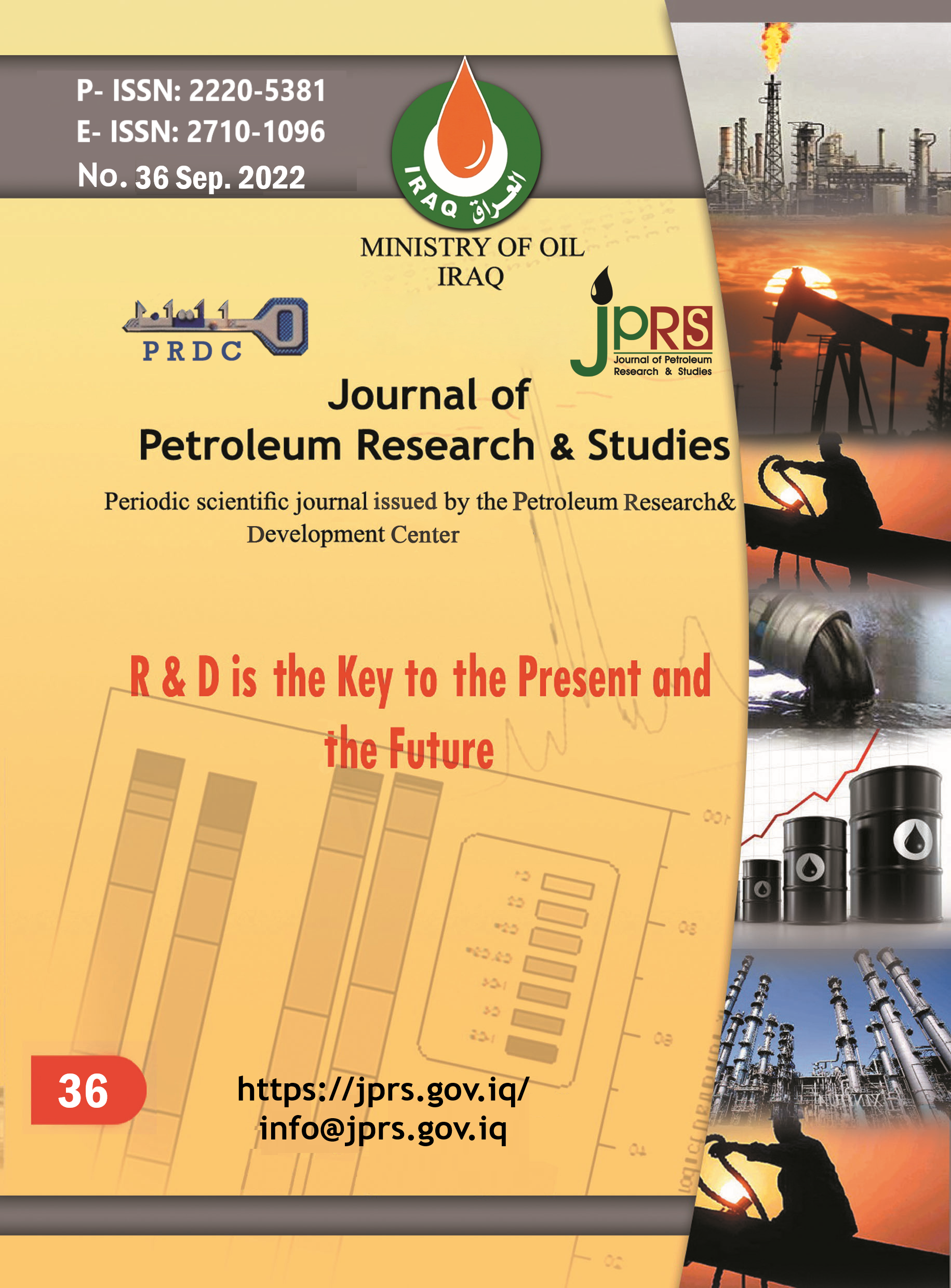Distribution of Petrophysical Properties Based on Conceptual Facies Model, Mishrif Reservoir/South of Iraq
DOI:
https://doi.org/10.52716/jprs.v12i3.556Keywords:
Facies model, 3-D Geological model, reservoir heterogeneityAbstract
A 3D geological model is an essential step to reveal reservoir heterogeneity and reservoir properties distribution. In the present study, a three-dimensional geological model for the Mishrif reservoir was built based on data obtained from seven wells and core data. The methodology includes building a 3D grid and populating it with petrophysical properties such as (facies, porosity, water saturation, and net to gross ratio). The structural model was built based on a base contour map obtained from 2D seismic interpretation along with well tops from seven wells. A simple grid method was used to build the structural framework with 234x278x91 grid cells in the X, Y, and Z directions, respectively, with lengths equal to 150 meters. The total number of grids is (5919732) in the geological model. CPI (computer-processed interpretation) for 7 wells contain (facies, porosity, water saturation, and NTG) was imported to Petrel 2016 software. Facies log was upscaled and distributed along the 3D grid. Truncated Gaussian with trend method was used to distribute the facies taking into account the conceptual facies model of the Mishrif formation. The result shows that the trend of sedimentation suggests a retrogradation pattern from NW to SE. Facies1 (Reservoir), dominated by Limestone brown to light brown, with oil shows has good distribution within the area and thinning towards the NW. The petrophysical properties (porosity, water saturation, NTG, and permeability) were distributed using the Sequential Gaussian Simulation (SIS) method and the facies model as a guide for distribution.
The results show that petrophysical properties enhanced in the southeast area, representing the reef region compared to the northwest side of the study area. Unit Mishrif B had the highest porosity value and lower water saturation value along the entire field. While the units Mishrif B1, B2, and B3 show a gradual decrease in reservoir properties towards the field's southeast side. The results also show that the conceptual facies model has great benefit in constructing the 3D geological model, reflecting the geological knowledge used to correctly distribute the reservoir properties (porosity and water saturation).
References
Orellana, N., Cavero, J., Yemez, I., Singh, V. and Sotomayor, J., “Influence of variograms in 3D reservoir Modelling Outcomes: An Example,” The Leading Edge, vol. 33 no. (8), pp. 890-902, 2014.
Al-Khalifa, M.A., Tobi, H. D. Payenberg, and Lang, S.C., “Overcoming challenges of building 3D stochastic reservoir models using conceptual geological models: A case study,” SPE Middle East Oil and Gas Show and Conference, SPE- 104496-MS, 2007.
Quinto S., Torino, P., and Weltje, G.J., “How to integrate basin-scale information into reservoir models,” Annual EAGE Conference and Exhibition incorporating SPE Europec, London, UK, SPE- 164830-MS, 2013.
Morton, R.A, Buster, N. A. and Krohn, M. D., “Subsurface controls on historical subsidence rate and associated wetland loss,” Transaction – Gulf coast association of geological societies, vol. 52, 2002.
Gaddo, J.H., “The Mishrif formation paleoenvironment in the Rumaila, Tuba, Zubair, region south of Iraq,” Journal Geol. SOC. Iraq, 4.1-2, 1971.
Alkersan, H., “Depositional environment and geological history of the Mishrif formation in the south of Iraq,” 9th Arab petroleum Congress, Dubai, UAE, Paper 121, pp.1-18, 1975.
Al-Sakini, J.A., “Summary of the petroleum geology of Iraq and the Middle east” In: Northern Oil Company press, Kirkuk, Iraq, pp. 179, 1992.
Aqrawi AAM, Thehni GA, Sherwani GH, Kareem BMA, “Mid- Cretaceous rudist bearing carbonates of the Mishrif Formation: an important reservoir sequence in the Mesopotamian Basin,” Iraq, Journal of Petroleum Geology, 21:57-82, 1998.
https://doi.org/10.1111/j.1747-5457.1998.tb00646.x
Sadooni, F. and Aqrawi AA, “Cretaceous sequence stratigraphy and petroleum potential of Mesopotamian basin, Iraq,” In; Alshrhan, A and Scoot, B., SEPM special publication 69, pp. 315-334, 2000.
Sadooni, FN, “The nature and origin of Upper Cretaceous basin-margin rudist buildups of the Mesopotamian Basin, southern Iraq, with consideration of possible hydrocarbon stratigraphic entrapment,” Cretaceous Research, vol. 26, no.2, pp. 213-244, 2005.
Aqrawi AAM, Goff JC, Horbury D, Sadooni, FN, Petroleum Geology of Iraq, Scientific Press Ltd, Beaconsfield, 2010.
Owen R. M. S. and Nasr, S. N., “The stratigraphy of Kwait-Basrah. In: Habitat of oil, a symposium AAPG, pp. 1252-1278, 1958.
Chatton, M. and Hart, E., “Review of the Cenomanian to Maastrichtian stratigraphy in Iraq”, OEC unpublished report, Baghdad, 1961.
Dunnington, H.V., “Generation, Migration, Accumulation, and dissipation of oil in northern Iraq,” AAPG, pp. 1194-1251, 1958.
Robinson, A. and Griffiths, P, the Future of Geological Modeling in Hydrocarbon Development: Introduction. 2th Ed., the Geological Society, 2008.
Schlumberger., Seismic- to- Simulation Software, Petrel Introduction Course. Schlumberger, pp: 50-334, 2008.
Schlumberger, Petrel Geology and Modeling, Petrel Introduction Course, pp. 559, 2013.
Deutsch C. V., “A sequential indicator simulation program for categorical variables with point and block data: Block SIS”, Computers and Geosciences, vol. 32, no.10, pp. 1669–1681, 2006.
Downloads
Published
How to Cite
Issue
Section
License
Copyright (c) 2022 Samira M. Hamd-Allah, Osamah Sh. Abbas, Mohammed K. Dhaidan

This work is licensed under a Creative Commons Attribution 4.0 International License.














